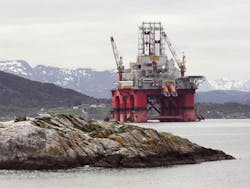Offshore staff
EDINBURGH, UK– Norway’s upstream development sector attracted a record $25 billion of capex last year, according to Wood Mackenzie’s latest review.
Malcolm Dickson, Norway upstream analyst, said much of the investment was directed at producing assets, “in particular on increasing recovery from giant fields like Ekofisk and Troll. Seven developments were sanctioned in 2012, which was lower than anticipated at the start of the year, but still healthy.”
Development spending is expected to rise this year as major projects get under way, includingEdvard Grieg, Martin Linge, and Ivar Aasen in the North Sea. However, the volume of work means that the country’s service sector is operating already at peak capacity, with costs increasing year-on-year.
This situation led to several projects being delayed last year.
“Project delays and overspend will be a common feature on the [Norwegian continental] shelf, as companies struggle to access rigs and equipment on time or in budget,” Dickson said.
As forexploration drilling in the sector, “although 14 discoveries were made in 2012, yielding 709 MMboe, this was down 8% from last year, and was below the 10-year average of 860 MMboe.”
The exploration and appraisal well count fell from 54 in 2011 to 43 in 2012, largely due to problems accessing rigs, and some drilling programs overrunning their schedules.
Notable finds included Havis in the Barents Sea, Zidane-2 in the Norwegian Sea, and Skarfjell and King Lear in the North Sea.
“Exploration is expected to increase in 2013,” Dickson added, “with up to 55 wells planned, including high profile prospects in the Barents Sea and the Utsira high – arguably Norway’s most prospective areas. Licensing will reach a new record high as mature and frontier rounds are due to be concluded in the first half of the year.”
He concluded: “In both the UK and Norway,mergers and acquisitions (M&A) activity was strong. However, the UK had a much higher number of deals, resulting in a huge overall value of $9.3 billion of assets traded. There are more companies active and more assets to trade compared with Norway and there is no state involvement.
“The capital investment that both the UK and Norway attract is testament to the booming sectors. When combined, the UK and Norway North Sea totals mean that the North Sea had the third highest upstream investment in 2012.”
1/10/2013



